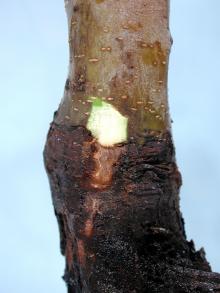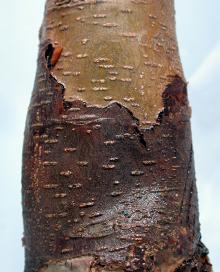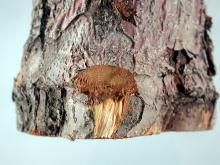See:
Apple (Malus spp.) - Fruit Rot, Phytophthora
Cause Phytophthora cactorum and other species, a soilborne fungus-like microorganism. Crown rot is a disease of the rootstock portion (or root crown area) of the tree; collar rot is a disease of the scion portion. Both are serious diseases of apple and other orchard trees in British Columbia, Washington, and Idaho, and have become a problem in Oregon orchards with clonal rootstocks, principally Malling Merton (MM) 106. Crabapple can also be infected. Pear scions are more susceptible than apple but popular pear rootstocks are much more resistant.
The fungus survives primarily as oospores in soil, organic debris, or infected tissues. Oospores produce a swimming spore stage (zoospores) when soils are at or near saturation. Zoospores swim to and infect roots. Movement within roots to the root crown is greatest between pink bud and shoot elongation. Saturated soils due to high rainfall, excessive irrigation, and/or poorly drained soils favor infection and disease development.
The fungus Athelia rolfsii (formerly) Sclerotium rolfsii has been isolated from trees with collar rot symptoms in eastern Washington. Overwatering was among the various issues in these orchards.
Symptoms In early fall, an affected tree shows bronzing, purpling, or yellowing foliage of one or more limbs, accompanied by bark reddening. There is a reduction in the size of leaves and terminal growth. Examination at the root crown or collar after scraping away the soil reveals dead bark. The cambium will be orange-brown to red-brown, eventually becoming dark brown instead of white. A distinct margin may separate healthy from infected tissues. In many cases, the tree may be completely girdled before its condition is noticed. Fire blight symptoms may be similar when confined to the rootstock.
Moderately resistant: MM111, M2, M7, M26, 'Golden Delicious', 'Delicious', and 'Rome Beauty'. Susceptible: MM104 and MM106.
Cultural control Water management that minimizes excessive water around the root crown is critical for management of this disease.
- Locate orchards on well-drained slopes if possible.
- Tile orchards or sites with poor drainage.
- Plant on a raised bed to help keep water away from trunks.
- Use resistant rootstocks. 'Antonovka', 'McIntosh', and 'Wealthy' apple seedlings, and M9 clonal rootstocks, as well as B9 and advanced selections in the Geneva series have shown high resistance to collar rot.
- Avoid the application of too much irrigation water.
- Do not let irrigation water repeatedly hit trunks.
- During summer, examine root crowns of trees for collar rot and scrape off diseased tissues. Leave root crowns exposed to the air until late fall.
- Avoid wounding root crowns. If a wound is made, keep it uncovered and open to the air for the rest of the season.
Chemical control Apply before Phytophthora symptoms appear, especially in orchards favorable for disease development. No chemical will revitalize trees showing moderate to severe crown rot symptoms. Although resistance has not been reported, alternate materials so resistant fungi do not develop quickly. The FRAC 4 and FRAC P7 fungicides used to manage Phytophthora do not kill this organism. They can only prevent establishment of the organism before it gets into the plant. They can also prevent continued growth if the organism is already inside the plant, thereby delaying symptoms that might have developed. Once chemical activity has subsided with time, the organism can resume growth within infected plants.
- Agri-Fos at 1.25 to 2.5 quarts/A. Do not combine with a copper-spray program for control of other diseases. Group P7 fungicide. 4-hr reentry. WA only.
- Aliette WDG at 2.5 to 5 lb/A. Spray foliage to run off. Follow manufacturer's directions for timing of spray. Do not apply within 14 days of harvest. Do not combine with a copper spray program for control of other diseases. Phytotoxicity may result if applied within 1 week of a copper spray. Do not use with adjuvants. Group P7 fungicide. 24-hr reentry.
- Fixed-copper products. Use 4 gal solution as a drench on the lower trunk of each tree in early spring or after harvest. Do not use if soil pH is below 5.5. Not considered organic since application is to the soil. Group M1 fungicides.
- Champ WG at 4 lb/100 gal water. 48-hr reentry.
- Cuprofix Ultra 40 Disperss at 2.5 lb/100 gal water. 48-hr reentry.
- Kocide 50 DF at 4 lb/100 gal water. 48-hr reentry.
- Nordox 75 WG at 2.5 lb/100 gal water. 12-hr reentry.
- Nu-Cop 50 DF at 1 lb/25 gal water. 48-hr reentry.
- Fosphite at 1 to 3 quarts/A. Do not use copper products within 20 days of treatment and do not use spray adjuvants. May also be injected into trunk. Group P7 fungicide. 4-hr reentry.
- MetaStar 2E at 1 quart/100 gal water. Apply diluted mixture (based on trunk size measured at 12 inches above the soil line) around each tree trunk. Group 4 fungicide. 48-hr reentry.
- Monterey Garden Phos at 2.5 to 5 teaspoons/gal water as a foliar spray or at 16 fl oz/16 fl oz water plus Pentra-Bark at 1 fl oz as a basal trunk spray. Group P7 fungicide. H
- OxiPhos at 1.3 to 5 quarts/A as a foliar spray. Group P7 fungicide. 4-hr reentry.
- Phospho-Jet is registered as a basal bark spray at 62.4 fl oz in 62.4 fl oz water plus 3 fl oz of Pentra-Bark. Spray first 5 feet of trunk including scaffold limbs until runoff. Group P7 fungicide. 4-hr reentry.
- Phostrol at 2.5 to 5 pints/A. Group P7 fungicide. 4-hr reentry.
- Rampart at 1 to 3 quarts/100 gal water/A. Do not use copper products within 20 days of treatment. Can also be trunk injected. Group P7 fungicide. 4-hr reentry.
- Reliant at 1.25 to 2.5 quarts/A as foliar spray or as a basal bark-spray at 62.4 fl oz in 62.4 fl oz water plus 3 fl oz of Pentra-Bark. Spray first 5 feet of trunk including scaffold limbs until runoff. May cause phytotoxicity when combined with some foliar fertilizers or copper products. Group P7 fungicide. 4-hr reentry.
- Ridomil Gold SL at 0.5 pint/100 gal water. Apply diluted mixture (based on trunk size measured at 12 inches above the soil line) around each tree trunk. Apply once at planting or in spring before growth starts. Apply again in fall after harvest. Group 4 fungicide. 48-hr reentry.
Reference Nyoni, M., Mazzola, M., Wessels, J.P.B. and McLeod, A. 2021. Phosphonate Treatment Effects on Phytophthora Root Rot Control, Phosphite Residues and Phytophthora cactorum Inoculum in Young Apple Orchards. Plant Disease. 105:3835-3847.






